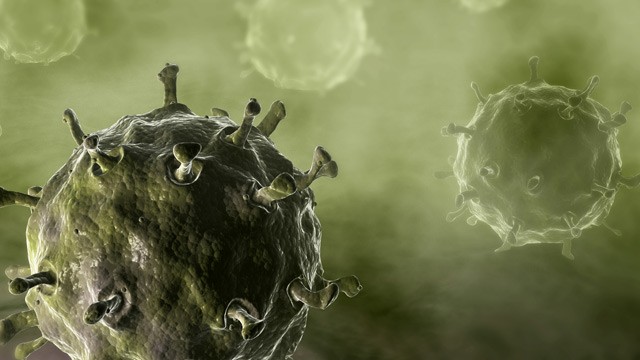To Catch a Micro-Predator

In the year 1878, an Italian poultry farmer awoke to a pen of dead chickens. Speechless at what could have happened to his livestock, he gathered the attention of local scientist Edoardo Peroncito. At the time, viruses and other microorganisms were still unknown to natural science, and Edoardo anyway lacked the electron microscope by which to analyze infectious particles. He could only surmise that the chickens had been hit by some rare plague. Thanks to his detailed descriptions we can conclude that it was there, along the plains of northern Italy, that we stumbled upon the first identified case of bird flu. The contagion proved particularly bloodthirsty and swiftly fatal, with a near-100% mortality rate in fowl species.
Since that time, similar strains have been found in several other avian varieties all across the globe and are collectively known as influenza A. While the genetics of this family of viruses has shifted considerably over the past two centuries, their instruction manuals have not been rewritten to pass easily from birds to humans or other mammals. Where it has happened, the disease has proved extremely deadly, killing around 60% of infected humans.
Mutation rates what they are, however, more earnest dangers always lurk just beyond the evolutionary knoll. And researchers now believe that the avian subtype H5N1 has begun to master the ability to jump to humans. In 2011 the World Health Organization released a troubling report of the documented H5N1 cases since 2003. Of the 566 people who were infected across 15 different countries, 332 died. If H5N1 were to successfully assimilate within the human genome, then not only could the virus pass from bird to human, but from human to human as well.
Fouchier’s Micro-Monster
Fearing the virus would soon evolve better adaptation to human hosts and escalate to pandemic proportions, two teams of researchers began to study samples of the mutant strain in late 2011. Ron Fouchier of the Netherlands, together with Adolfo García-Sastre and Yoshihiro Kawaoka of the U.S., took the reins. With an assignment of international importance, the collaborators repaired to their intensively air-secured facilities and kicked off what would soon become an international controversy.
Experts had known for some time that avian strains were trending toward the type that infect mammals. If Fouchier and his team could predict the next batch of mutations, they could beat the virus to the finish line and take preemptive measures to vaccinate against it. And that’s just what the teams set out to do. They first compared the genomes and mutation rates of similar strains to chart an anticipated course. The next step was to alter the biochemistry of H5N1 accordingly, shuffling the order of nucleotides and deactivating certain DNA segments as necessary. All of this genetic tinkering granted the virus new abilities and potency, the most disturbing of which was airborne transmission: it now had the capacity to move through airways and latch onto the host’s cells without any direct contact. The result was achieved with just four mutations.
Fouchier’s team used ferrets as their mammalian proxies, directly exposing them to the synthetic strain. Just as they had expected, the newly liberated microbe spread rapidly among the test subjects. As it turns out, virus behavior in ferrets parallels that of humans, raising the likelihood that Fouchier’s lab-engineered creation could be carried into a new human host by merely a cough or sneeze. Fouchier had created a living micro-monster.
Not Fit for Public Consumption
 Eager to publish the results, the teams immediately filed for syndication in Nature and Science. The details of the research had hitherto passed largely under the radar of oversight agencies, and the reports quickly caught the attention of international security teams. The US National Science Advisory Board for Biosecurity declared the reports unfit for public consumption and asked the journals to redact the jeapordous bits prior to publication. If this data made it into the wrong hands, they reasoned, we could suffer a terrorist incident on par with man’s worst envisioning. The journals denied the request, objecting that the NSABB’s concerns over “dual-use” research were outpaced by the benefits that openness would bring to public health.
Eager to publish the results, the teams immediately filed for syndication in Nature and Science. The details of the research had hitherto passed largely under the radar of oversight agencies, and the reports quickly caught the attention of international security teams. The US National Science Advisory Board for Biosecurity declared the reports unfit for public consumption and asked the journals to redact the jeapordous bits prior to publication. If this data made it into the wrong hands, they reasoned, we could suffer a terrorist incident on par with man’s worst envisioning. The journals denied the request, objecting that the NSABB’s concerns over “dual-use” research were outpaced by the benefits that openness would bring to public health.
Yoshihiro Kawaoka tells The Guardian: “Research to understand how avian virus is adapted to mammals will lead to better surveillance and vaccines… We know that in nature H5N1 viruses in birds are becoming more like viruses that infect mammals. Therefore, the greater risk is not doing research that could help us be better equipped to deal with a pandemic. We want the world to be better prepared than we currently are when an H5N1 virus poses a pandemic.”
The impasse reached a crescendo last January, when all parties agreed to a moratorium on further research on lab-engineered H5N1. It became evident that the protocols for “dual-use” research were too ill-defined and needed to be addressed before further data of this magnitude were released into the wild.
The back-and-forths, which included painstaking risk assessments, lasted a full year. While the original teams were able to publish censored versions of their reports in the interim, all research stalled on H5N1. That freeze has been lifted this week. The WHO and its international counterparts have codified more transparent guidelines which aim to minimize the risks involved with these synthetic trials, and research teams can continue preparing for a human-adapted H5N1 pandemic. When the great leap to our species inevitably occurs, scientists hope to have a vaccine at the ready.
Creation and Destruction
Although harmful agents can be found in containment labs all across the world, the H5N1 controversy rehabilitates critical questions with regard to the sensitivity of certain research and its relationship with global connectedness. To what extent does a higher level of collaboration, in which data flows freely among more organizations, fast-track vaccines or accommodate security leaks? Moreover, scientists are now able to munition new hybrid viruses as well as obsolete viruses like polio and even the 1918 Spanish influenza. Do the benefits of preemptive pathogenic research outweigh the risks of infectious agents escaping the lab or falling into the wrong hands?
Such is the inescapable tension faced by today’s policymakers and microbiologists. With H5N1 we are facing a virus that has historically been confined to avian species but has since diverged down an evolutionary path that poses serious risks to us all. How best to approach this crisis, given the plenteous resources at our disposal, is a matter of staunch debate.
“There is probably not a scientific issue in recent times that has been so widely thrown out for public consultation as this one,” said Wendy Barclay, an influenza virologist at Imperial College London. “The information learned from the two publications that finally made it into Nature and Science last year has been processed by the influenza community and has been hugely informative, not only for understanding the risks from H5N1 but also for illuminating how other subtypes of flu might jump species and even for assessing the zoonotic risks from other pathogens. The lifting of the moratorium will undoubtedly lead to more scientific revelations that will have direct consequence for human and animal health.”
Had we been equipped with these tools back before HIV jumped the species barrier from chimpanzees to humans, we might have fared better against its onslaught. By successfully charting the genetic course of H5N1 and other pathogens, it just might be possible to balance the scorecard between virus and man.
Further reading:
- The Evolution of Bird Flu, and the Race to Keep Up
- Bird flu researchers get green light to continue work on engineered virus
Feature image credit: MedicalRF.com/Getty Images via abcnews


Comments